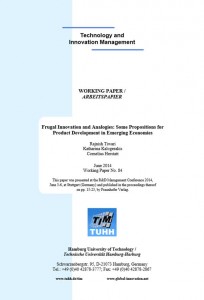 A new paper that seeks to generate some preliminary insights on the use of inventive analogies in the process of creating frugal innovations. The paper has been authored by Rajnish Tiwari, Katharina Kalogerakis and Cornelius Herstatt and was presented at the recently-held R&D Management Conference (June 3-6, 2014) in Stuttgart.
A new paper that seeks to generate some preliminary insights on the use of inventive analogies in the process of creating frugal innovations. The paper has been authored by Rajnish Tiwari, Katharina Kalogerakis and Cornelius Herstatt and was presented at the recently-held R&D Management Conference (June 3-6, 2014) in Stuttgart.
Abstract
Frugal products and services aim at satisfying the unsaturated demand of a large and growing middle class in many “emerging economies”. Although research has been conducted in regard to the strategic importance of frugal innovations, so far, the actual development process of such innovations has not been looked into in detail. Some examples show that inventive analogies are used to develop frugal innovations. For instance, the development of a frugal artificial heart was based on the heart structure of cockroaches, which led to a reduction of costs by 20 times.
The aim of this paper is to examine the use of inventive analogies in creating frugal solutions and their impact on project results. Based on three explorative case studies from India, the authors generate preliminary evidence that analogies can make a significant impact on the successful development of innovations in environments that are characterized by severe resource constraints and high price-sensitivity. Furthermore, the inherent aim of frugal innovations to create radically new solutions with very restricted resources seems to stimulate the application of inventive analogies. The results point to some valuable learnings in regard to an effective employment of analogies. Besides, useful insights for companies that want to exploit market opportunities in the emerging economies are generated.
The paper can be downloaded as a Working Paper version of the TIM-TUHH.
